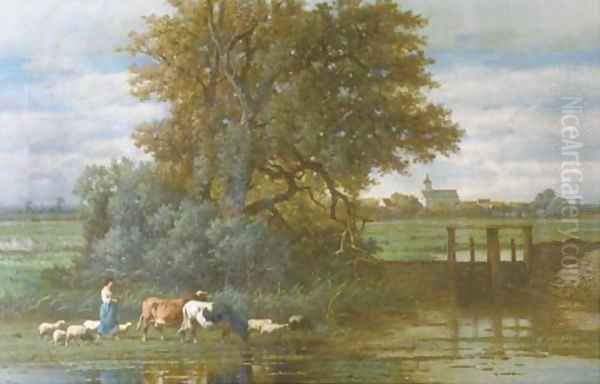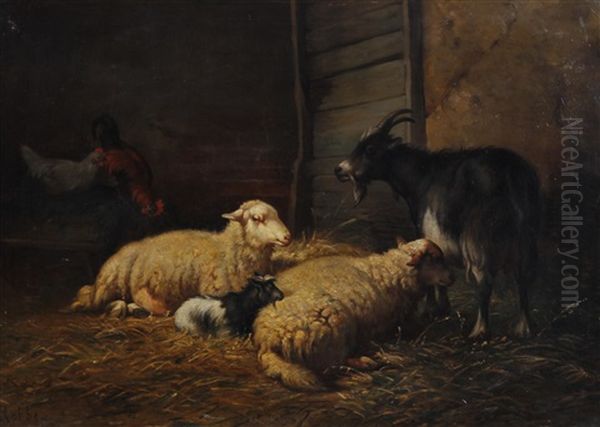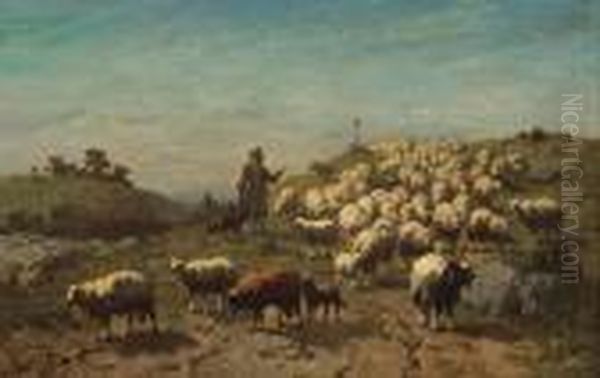Louis Marie Dominique Romain Robbe stands as a significant figure in 19th-century Belgian art, celebrated primarily for his mastery in depicting animals within the framework of Realism. Born in Kortrijk (Courtrai), Belgium, in 1806, and passing away in Brussels in 1887, Robbe navigated a unique path, successfully balancing a demanding legal career with a profound dedication to his artistic pursuits. His legacy is defined by his sensitive, detailed, and often tranquil portrayals of rural life, positioning him as a key proponent of Realist animal painting in his homeland.
Early Life, Education, and Dual Paths
Robbe's upbringing provided a foundation for his dual interests. His father served as a judge, setting a clear precedent for a career in law. Following this path, Louis Robbe pursued legal studies with diligence, ultimately earning a doctorate. This academic achievement led him into the legal profession, where he practiced as a lawyer and later served as a Justice of the Peace in Moorslede (referred to as Mooresee in some sources). This commitment to law demonstrated a capacity for rigorous intellectual work and civic responsibility.
However, the pull towards art was equally strong, likely nurtured from a young age. Sources indicate his father was not only a lawyer but also an amateur painter, potentially providing early inspiration. Robbe sought formal art training, studying under Jean-Baptiste De Coninck (J.-B. De Coninck) in Kortrijk. De Coninck, active in the earlier part of the 19th century, represented a more traditional approach, likely rooted in late Neoclassical or early Romantic landscape conventions. This initial training would have provided Robbe with foundational skills in drawing and composition, upon which he would build his distinct Realist style. The decision to actively pursue painting alongside his legal duties highlights an exceptional dedication and passion for the arts.
The Emergence of a Realist Vision

Robbe's artistic identity solidified around the principles of Realism, a movement that gained significant traction across Europe in the mid-19th century. Reacting against the idealized historical and mythological subjects of Neoclassicism (epitomized by artists like Jacques-Louis David) and the dramatic emotionalism of Romanticism (seen in the works of Eugène Delacroix or Théodore Géricault), Realism sought to depict the world truthfully and objectively, focusing on contemporary life and ordinary subjects.
For Robbe, this translated into a deep engagement with the rural landscapes and, most notably, the animals that inhabited them. He became renowned for his depictions of cattle, sheep, and donkeys, often shown in pastoral settings or within the rustic confines of barns and stables. His approach was characterized by meticulous observation and a remarkable ability to render textures – the coarseness of fur, the softness of wool, the roughness of wooden beams, the dampness of earth. He paid close attention to anatomical accuracy, giving his animals a tangible presence and often capturing subtle aspects of their individual character or disposition.
Mastery of Light and Atmosphere
A defining feature of Robbe's work is his skillful handling of light and atmosphere. While firmly a Realist, his paintings often possess a tranquil, almost poetic quality. He excelled at capturing the effects of natural light, whether it be the soft, diffused light filtering into a barn interior or the warmer glow of sunlight on a pasture. This sensitivity to light contributes significantly to the mood of his paintings, often evoking a sense of peace and harmony with nature.
His treatment of light and shadow, while grounded in observation, sometimes echoes the atmospheric depth found in the works of the Dutch Golden Age masters. While stylistically distinct, the careful modulation of light to create volume and mood might recall, in principle, the achievements of artists like Rembrandt van Rijn or the serene interiors of Johannes Vermeer. However, Robbe's primary influence from this era is widely acknowledged to be Aelbert Cuyp, the 17th-century Dutch painter celebrated for his idyllic landscapes bathed in a characteristic golden light, often featuring cattle prominently. Robbe absorbed Cuyp's appreciation for pastoral subjects and atmospheric effects, integrating them into his own Realist framework.
Influences and Artistic Context

Beyond the specific influence of Aelbert Cuyp, Robbe's work reflects broader artistic currents. His focus on animal subjects places him in a lineage that includes Dutch and Flemish masters like Paulus Potter, renowned for his detailed and naturalistic animal paintings centuries earlier. The rise of the Barbizon School in France, contemporaneous with Robbe's mature period, also provides a parallel. Artists like Jean-François Millet and the animal painter Constant Troyon similarly turned to rural life and landscape, emphasizing realistic depiction and often imbuing their scenes with a sense of dignity and quietude, though sometimes with a greater emphasis on the hardships of peasant life than seen in Robbe's generally more serene works.
The influence of Romanticism, despite Realism's reaction against it, is also subtly present in Robbe's art. The choice of tranquil rural scenes, the harmonious portrayal of nature, and the slightly idealized vision of country life connect with Romantic sensibilities regarding nature as a source of solace and beauty. This fusion of precise Realist technique with a gentle, almost Romantic atmosphere became a hallmark of his style. He respected form and nature, achieving a harmonious balance in his compositions.
Key Themes and Representative Works
Robbe's oeuvre consistently revolved around the depiction of domestic animals within their natural or agricultural environments. Cattle grazing peacefully in fields, sheep huddled together in dimly lit barns, or solitary donkeys standing patiently in their stalls are recurrent themes. These subjects allowed him to explore his fascination with animal anatomy, texture, and the interplay of light, while also celebrating the quiet rhythms of rural existence.
Several works exemplify his style and thematic concerns. A Country Idylle (oil, 53.5 x 80.5 cm), held by Christie's according to sources, likely captures a peaceful pastoral scene, embodying the idyllic aspect of his work. The title itself suggests a romanticized yet realistically rendered view of country life.
A Donkey in a Loosebox (oil, 34.9 x 54 cm) showcases his ability to handle interior scenes and focus on a single animal subject. One can imagine the careful rendering of the donkey's coat, the texture of straw underfoot, and the play of light within the stable, creating an intimate and closely observed portrait.
Sheep in a Barn (oil on panel, 41 x 56 cm) is another characteristic work, likely depicting a group of sheep within a rustic interior. Such scenes allowed Robbe to demonstrate his skill in portraying multiple figures, differentiating textures (wool, wood, hay), and managing complex light conditions within an enclosed space. These works collectively highlight his commitment to realism, his technical proficiency, and his consistent focus on animal life.
Exhibitions, Recognition, and Belgian Context

Louis Robbe achieved considerable recognition during his lifetime. He regularly exhibited his paintings at important Salons in Belgium and abroad, including Ghent, Bruges, Brussels, The Hague, Breda, Paris, and London. Success at these official exhibitions was crucial for an artist's reputation and commercial success in the 19th century. Robbe's work was well-received, earning him awards and accolades.
His stature within the Belgian art establishment was confirmed by his election as a member of the Royal Academy of Science, Letters and Fine Arts of Belgium. This prestigious appointment underscored his importance and the respect he commanded among his peers. His realistic yet accessible style found favour with collectors not only in Belgium but also internationally, particularly in France and the United Kingdom, indicating a broad appeal that transcended national borders. His works commanded respectable prices on the art market.
Robbe emerged during a period of national consolidation and artistic flourishing in Belgium following its independence in 1830. The 19th century saw the rise of a distinct Belgian school of Realism. While artists like Constantin Meunier focused on the depiction of industrial labourers and Charles de Groux explored social themes, Robbe carved out his niche in animal painting and rural landscapes. His work can be seen alongside that of landscape painters like Hippolyte Boulenger, associated with the Tervuren School (Belgium's equivalent of Barbizon), who also sought truthfulness in depicting local nature. He stands somewhat apart from the grand historical narratives favoured by earlier Belgian Romantics like Gustaf Wappers or Nicaise de Keyser. Perhaps his closest Belgian peer in terms of subject matter, though often with a different sensibility, was Eugène Joseph Verboeckhoven, another highly successful painter of animals, active slightly earlier and concurrently.
Legacy and Conclusion
Louis Robbe is rightly regarded as a pioneer of Realist animal painting in Belgium. His dedication to meticulous observation, combined with a sensitive handling of light and atmosphere, set a high standard for the genre. He successfully navigated the demands of two distinct professions, demonstrating a remarkable capacity for both intellectual rigour and artistic creativity. While the available information doesn't point to him leading a specific 'school' or having a large number of direct pupils, his influence was felt through the quality and consistency of his work, which was widely exhibited and collected.
His paintings offer a window into the rural life of 19th-century Belgium, rendered with honesty but often imbued with a sense of tranquility and pastoral charm. He demonstrated that everyday subjects, particularly the animals that shared the landscape with humans, were worthy of serious artistic attention. By focusing on the textures, forms, and quiet presence of these creatures, Robbe created a body of work that remains appreciated for its technical skill, its gentle realism, and its enduring connection to the natural world. His contribution lies in his mastery of a specific genre and his role in establishing Realism as a vital force within Belgian art.